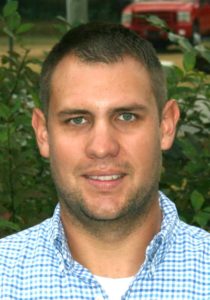Wesley Porter: An Innovator in Precision Ag Research and Education
Editor’s note: The University of Georgia’s Wesley M. Porter, Ph.D., is one of the recipients of the 2019 PrecisionAg Awards of Excellence. Here he shares how he got started in precision ag, the evolution of precision practices, and who has influenced him most in his career.

Wesley Porter
Dr. Wesley Porter has made a name for himself as an innovator in his still relatively young career, gathering a wealth of accolades and accomplishments too lengthy to list here. Currently responsible for precision agriculture and irrigation Extension education at the University of Georgia, he has lectured at Clemson University, Oklahoma State University, University of Georgia, Abraham Baldwin Agricultural College, and Kansas State University, and has been an invited speaker at many nationally recognized conferences.
“Dr. Porter is a quintessential educator and his impact lies in the ability to teach complex topics to lay audiences with a relaxed delivery,” says his nominator, Dr. Randy Taylor.
With a unique ability to bridge agronomic and engineering disciplines, Porter has focused his research efforts on precision seeding and optimizing nutrient application. His cutting-edge work in cotton seeding has resulted in more accurate and consistent seed depth and more spatially and temporally uniform emergence. “By researching the interaction of seeding depth and rate along with soil moisture and temperature on emergence, he will be able to take advantage of new planter technology to spatially optimize seed placement,” Taylor says.
MORE BY JACKIE PUCCI
Michael Ott: Taking Drone Application from the Drawing Board to the Field
Porter is also an integral part of a precision irrigation team that is densely locating soil moisture sensors within fields to aid precision irrigation decisions. They have tested the UGA Dynamic Variable Rate Irrigation system on farmer fields for the past three years on peanut and for one year on corn and cotton. This team effort has achieved irrigation water use efficiency gains ranging from 16% to 40% and yield gains ranging from 2% to 4% in peanuts and they are optimistic that similar results will be found with other crops. With agricultural water use under increased scrutiny, this approach has the opportunity to optimize water use without negatively affecting yield and puts agricultural producers in a proactive position to conserve water.
PrecisionAg chatted with Porter on his path and thoughts on the evolution of precision practices.
ON GETTING HIS START: “I’m originally from upstate South Carolina, and when I got almost old enough to drive, I started working on a couple of small farms in the upstate area. I went to Clemson University for undergraduate. At that time, I spent some time on Clemson research farms, and was really interested in precision agriculture – I thought it was really cool. At that time, auto-steer and some of those technologies were getting kind of big. I saw computers in ag and what they could do. Then, I got my Master of Science in Ag Engineering on remote sensing and in-season nitrogen management in cotton.”
ON CHANGING PRACTICES: “I have worked with two different farmers doing some planter control system work in the past couple of years, and because of what we’ve done with them, they made decisions to move to more advanced planters with better control systems for singulation of seed and for control of their downforce system to ensure they’re getting maximized emergence out in their fields. Based on that, it gave them insight on what machinery they needed to be using. They have been able to become more efficient in the field to where they’re covering more acreage per day. Where they needed multiple pieces of equipment before, they are now able to do the same job with one or two pieces of equipment, and cover area a little bit better with confidence that the systems are doing what they are supposed to do.
“More and more over time, we are seeing changing precision practices. We are looking at farmers’ needs and also looking at different production practices mixed in and different equipment styles. We are looking where we can be more sustainable in production practices, in terms of applying inputs and general crop production practices. These include changing tillage methods, irrigation scheduling, and timing of fertilizer – when and how much to apply to make ourselves more sustainable. We’re using the technology available to us to make those in-season, pre and post decisions to make sure we are validating what we are doing out in the field.”
ON UNTAPPED OPPORTUNITY: “I think there is still tremendous opportunity. We’ve seen dramatic increases in the number of farmers in the state using more advanced methods including computer models and soil moisture sensors. By implementing those methods, they have the ability to better target how much water a crop needs to become more sustainable, because they are better targeting the crop water requirement at that point and maximizing the efficiency of that crop.
“We always see technology change and the progression in agriculture. It’s an exciting time, where we’re starting to look at more utilization of robotics in ag and more unmanned vehicles, both on the ground and aerial-based, for making some of these decisions and changes. As we see time progress, we’re going to see those help us become more efficient with our farmer practices.”
ON HIS MENTORS: “In putting me I’m on the path I’m on now, I have to give credit to my advisors. Dr. Ahmad Khalilian from Clemson was my research advisor; he got me into the in-depth field research portion of precision ag. At Oklahoma State I worked under Dr. Randy Taylor. Randy really taught me the good value of Extension and how to take the work we’re doing on the research side out to our producers.”
ON WHAT HE ENJOYS MOST: “I really enjoy working in the Extension realm and working with our Extension agents and producers on improving their production practices. Anything we can do from the university side for the Extension side, that’s what I’m here for and what I get enjoyment out of my job doing.”
Read about all of the 2019 PrecisionAg Awards of Excellence winners.










